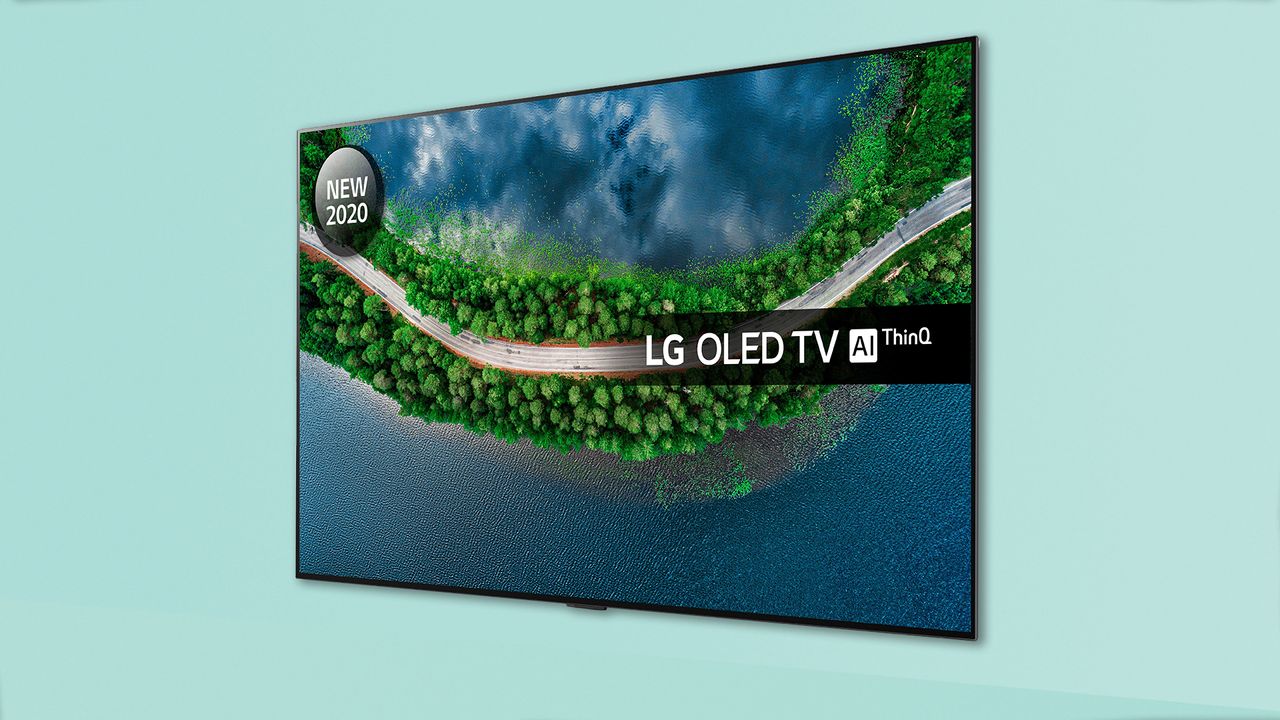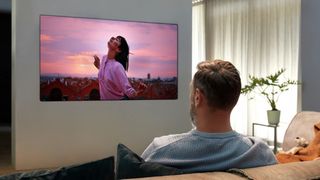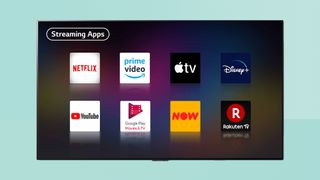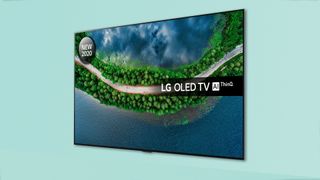LG GX OLED (OLED65GX) review: a beautiful 4K OLED TV in every sense
The LG GX gives you an OLED TV that's packed with features in a stunning design, but is it worth the price premium over the CX?

The LG GX OLED TV (OLED65GX) is well worth considering thanks to its striking design and excellent image quality – its AI sound and vision enhancements are particularly formidable. But issues with usability, a lack of UK catch-up TV and a hefty price premium hold it back a little.
-
+
Slick, minimalist design
-
+
Excellent AI Picture and Sound modes
-
+
Advanced gaming features
-
-
No Freeview Play
-
-
No HDR10+ support
-
-
Not the brightest HDR
Why you can trust T3
From this LG GX (OLED65GX6LA review, you'll find out why the GX is LG’s greatest series of ‘Gallery’ TVs, meaning that it pairs the same fantastic 4K OLED panels and processing you’ll find in the cheaper LG CX TV with a fancier and thinner design, and beefed up speakers.
This does put the GX in a slightly awkward spot: LG’s generosity in putting its best panels in its lower-priced TVs means that with little to separate the higher-tier models on image quality, the hierarchy is largely defined by cosmetics.
Beyond the panels, feature attractions include the brand’s latest AI-enhanced image processing technologies and webOS smart functionality – again, shared with other models in the range. This sharing of the top tech is what's always kept LG's OLEDs so high in our lists of the best OLED TVs as well as the best TVs overall, of course.
This is a 4K TV – though some of the best 8K TVs are becoming affordable, 8K OLED still lies in ‘footballer and sheikh’ territory. Otherwise, it’s fully cutting-edge on features, including gaming tech ready for what PlayStation 5 and Xbox Series X can do… but then, so is the much cheaper LG BX.
LG GX OLED review: Price & features
Intended primarily as an on-wall design – hence its ‘Gallery’ moniker and thin design – the GX can be mounted flush against the wall using a dedicated bracket. There’s no stand in the box at all, but you can buy a set of feet as an extra, so it can sit on a TV unit.
Available in 55-, 65- and 77-inch sizes (dubbed OLED55GX, OLED65GX and OLED77GX respectively), we tested the 65-incher, and opted for the stand-mount configuration, with L-shaped feet left and right. The ensemble looks suitably swish but you’ll need wide AV furniture to accommodate the set, since the feet are at the ends rather than the centre.
The GX is the most expensive of LG’s mainstream OLED offerings this year, starting at £2,299/$2,500/AU$4,139 for the 55-inch model, £3,499/$3,500/AU$5,999 for the 65-inch model we tested, and £5,999/$6,000/AU$11,399 for the 77-inch version. By way of comparison, LG's step-down CX 65-inch TV sells for £2,799/$2,800/AU$5,399. That’s a hefty £700/$700/AU$600 price premium over the corresponding CX model, given that the image quality is the same.
Image processing comes from LG’s latest Alpha Gen 3 chip, and there’s support for Dolby Vision HDR and Dolby Vision IQ (which adjusts brightness based on the light in the room, so the image always looks its best). There’s no HDR10+ support, though.
Connectivity is good. Four HDMIs support 4K at 120Hz, with an eARC-ready connection too. As we’ve seen on the new Samsung QLEDs such as the Q80T, these HDMIs feature functionality cherry picked from the HDMI 2.1 specification.
Gamers will appreciate ALLM (auto low latency game mode), VRR (Variable Refresh Rate) – both of which are supported by next-gen consoles – and Nvidia G-Sync support for smoother PC gaming, which is not common at all on TVs.
In addition there are three USBs, an optical digital audio output, and Ethernet LAN to support Wi-Fi and Bluetooth. The set is also AirPlay 2 compatible, for streaming video to it directly from Apple devices.
The GX sports both a terrestrial and single satellite tuner. Rather unfortunately for UK users, the former is no longer Freeview Play, owing to some sort of rift between LG and the nation’s digital video broadcast platform (more of which later). So we get regular Freeview HD.

LG GX OLED review: Picture quality
The OLED65GX delivers stunning images, with some minor caveats. Simple things first: out of the box and powered up, switch off Energy-saving mode, as it's on auto as a default. Disabling it results in an immediate lift in average picture level. Also avoid the set’s Eco picture preset for much the same reason.
However, do engage LG’s AI Picture Pro processing, as it’s genuinely impressive. It snaps detail into focus, without obvious over-sharpening or edge emphasis. Skin texture becomes more believable, fabric more visually tactile.
The GX is also one of the first TVs we’ve seen in the wild to offer Filmmaker Mode. This new Hollywood-endorsed image preset aims to mimic the picture characteristics of a post-production monitor.
LG has enabled the TV to auto-switch to Filmmaker Mode when when you play something that’s been flagged to enable the mode (although there’s nothing that does this, presently), but it can be manually selected as an image preset.
Filmmaker Mode automatically corrects frame rate (which is good) but also disables LG’s carefully crafted image processing (which is not so welcome).
In actuality, there’s actually not a great deal of difference between Filmmaker Mode and LG’s own Cinema mode; the exception is some low-level noise reduction used on the latter.
For everyday viewing, it’s the Standard mode which best exploits the panel’s natural attributes. With Standard, the image looks subjectively crisper with a higher average picture level.
Filmmaker Mode looks its best with 4K content, because it doesn’t dim down as much as with SDR HD.
The set also has Dolby Vision IQ functionality, not that you’ll notice. There’s no specific labelling. Instead, when you select the Dolby Vision Cinema Home preset it triggers the set’s AI Brightness Control function, which uses the on-board ambient lighting sensor to adjust the image based on viewing conditions – boosting it when the room is bright, and bringing it down a little in dim conditions.
The LG GX’s HDR performance is in line with previous LG panels. We measured an HDR peak at around 800 nits, which is more than enough for bright specular highlights (light flares, reflections, fireworks, that kind of thing). However that figure is only achievable on the set’s Vivid setting, which is not one of our recommended viewing modes.
In Standard, the set’s HDR peak brightness is a tad less, around 750 nits. Opt for one of the Cinema-style modes, and you’ll restrict highlights to just 650 nits (consistent across 5 per cent and 10 per cent measurement windows). This is comparatively low.
Both Panasonic (with its hard-driven pro OLED display) and Philips have come in brighter with similar OLED sets. And the best LED TVs can go way beyond this – Samsung’s new QLED sets, including the mid-range Q80T and the high-end 8K Q950TS both offer stronger brightness.
Of course, OLED’s advantages really comes from the authenticity and nuance in the dynamic range, rather than brightness, and we were absolutely wowed by the set in this regard.
Picture depth is outstanding, perfect for big 4K close-ups. The sense of texture, courtesy of the set’s Alpha 9 Gen 3 processor, is supreme. We did note some overt grain on largely still images, presumably created by AI image enhancement, but with moving content this wasn’t an issue. High-speed action sequences are crisp and fluid.
LG’s image interpolation solution, Trumotion, is available in Smooth, Natural, Cinema Clear or user adjustable settings, the latter with de-judder and de-blur sliders.
There's also OLED Motion Pro with Black Frame Insertion, which really robs the screen of brightness. Steer well clear. The temptation is to leave the TV on Cinema Clear, or turn off Trumotion altogether.
Like the industrial design, the set’s gaming performance is upper class, recording a low latency of just 13.2ms (1080/60) in Game mode. By way of comparison, if you play in Standard, image lag is a tardy 79.7ms.

LG GX OLED review: Sound quality
Despite its lack of cabinet depth, the GX actually has an effective onboard audio system. For general viewing, the downward-firing drivers are perfectly fine. There are EQ modes for Standard, Cinema, Clear Voice, Sports, Game and Music, bolstered by a hefty 60W of amplification.
However, by engaging the set’s secret weapon, specifically its AI Sound Pro mode, you might even be persuaded that you don’t need to rush out to buy a separate soundbar.
With AI Sound switched on, the soundstage audibly steps forward, improving the perception of depth. Without this, the set’s downward-firing stereo system almost sounds timid.
The GX is compatible with Dolby Atmos content, and will pass through an Atmos bitstream to a compatible device over HDMI, if you do decide to pick up one of the best soundbars.

LG GX OLED review: Design & usability
Unlike many rival OLEDs, the screen doesn’t adopt a wafer-thin panel with sagging electronics bulge in the centre. The screen depth is uniform top to bottom, just 20mm thin.
The panel itself is framed by a minuscule bezel, just 5mm at its thinnest, so all you see is the screen.
For smooth control, the GX comes with LG’s familiar Magic remote control. LG has made some minor changes to its webOS smart platform but the resulting usability isn’t necessarily for the better.
The system adopts the same two-tier design from 2019, and the app selection remains comprehensive, including NOW TV, Netflix, Rakuten TV, Prime Video, Disney Plus, YouTube, and Apple TV. But UK catch-up TV apps are conspicuous by their absence.
LG tells us it’s negotiating to secure individual channel players, and there’s no reason to think they won’t come soon via an update, however for the time being be aware that they’re AWOL, which does put the TV at a disadvantage compared to other brands. You can easily add channels by picking up one of the best 4K media streamers, but should you have to?
As we intimated, we have some reservations about the set’s new user interface. What was once clean cut and intuitive is now beginning to look a little busy.
The new Home Dashboard, a central hub for sources, is stylistically unconnected to anything else on the platform. It’s from here you can connect your mobile device, take advantage of AirPlay, or access content on USB or networked servers.

LG GX OLED review: Verdict
There’s no doubting the GX Gallery OLED series is an impressive achievement. Its cosmetic design is top notch, and overall image quality is similarly accomplished. The execution of AI image processing is subtle and effective, although HD upscaling can’t really claim an edge over rivals. The absence of Freeview Play, with zero UK catch-up players, is more of an issue (although this could and should be resolved).
LG’s principal competition, as always, tends to come from its own ranks. We suspect that most people will be drawn towards the more affordable CX range, since it gives you the same image quality for cheaper (and comes with a stand in the box).
We also need to note that the GX (and CX for that matter) are landing in a current market where last-year’s fantastic LG C9 is still available, offering very nearly as good image quality and most of the same features, but for under £2,000/$2,200 (AU$5,589) at 65 inches (and, in the UK, actually does have the catch-up services the GX is missing).
In terms of new 2020 sets, there’s also stiff competition to be had from Panasonic’s HZ2000, which offers a high-brightness HDR panel (around 20% brighter than the LG, which is definitely a visible change), a full-blown Dolby Atmos sound system built-in and universal HDR support.
And in terms of having a spectacular design piece, Samsung’s Q950TS is still up there as the TV to beat. Its minute bezels look like the picture is floating in the air, and its 8K panel and huge brightness are spectacular (though can’t quite match the GX for nuance in dark areas).
Sign up to the T3 newsletter for smarter living straight to your inbox
Get all the latest news, reviews, deals and buying guides on gorgeous tech, home and active products from the T3 experts
For over 25 years, Steve has been casting his keen eyes and ears over the best that the world of TV and audio has to offer. He was the creator of Home Cinema Choice magazine, and contributes to huge range of technology, home and music titles along with T3, including TechRadar, Louder, Ideal Home, the i newspaper, and more.
-
 This dark 2015 sci-fi movie took me by surprise – now it's on Netflix
This dark 2015 sci-fi movie took me by surprise – now it's on NetflixHigh-Rise is a weird but excellent film
By Max Freeman-Mills Published
-
 HBO's The Wire actor captivates in new Netflix Top 10 movie
HBO's The Wire actor captivates in new Netflix Top 10 movieMichael K Williams stars posthumously in Breaking, now streaming on Netflix
By Mike Lowe Published
-
 The North Face brings next-level propulsion to the trails with VECTIV 3.0
The North Face brings next-level propulsion to the trails with VECTIV 3.0The outdoor giant just announced four new shoes, including the latest iteration of the Summit VECTIV Pro
By Matt Kollat Published
